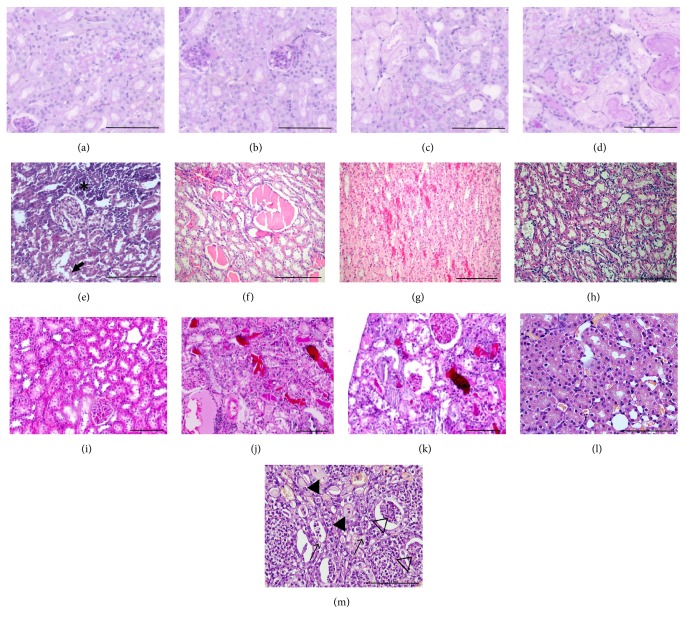Figure 4.
Histopathology of CI-AKI models with RCM administration and hypoxia. (a–d) RCM + renal ischemia mouse model (unpublished own data) (PAS, 400x). (a, b) Hypoxic tubular damage in mice 24 h after Omnipaque 350 iv. alone but no additional ischemia: besides vacuolization and mild tubular cell injury, no necrosis can be observed. Proximal tubuli have an intact brush border. (c, d) Ischemic changes in mice after 22 min ischemia + Omnipaque 350 iv. + 24 h reperfusion: more severe tubular damage, flattening of tubular epithelial cells, loss of nuclei, dilation of tubular lumen, and cast formation demonstrate tubular necrosis. (e) RCM + indomethacin rat model. Necrotic tubular cells (arrow) and inflammatory cell infiltration (∗). (RCM (10 mL/kg iomeprol), indomethacin (10 mg/kg), and HE, 200x, [34]) (f–h) RCM + dehydration rat model. Tubular casts (f, g), medullary congestion (g), and tubular necrosis (h) (72 h dehydration + RCM, HE, 200x, [35] with permission). (i–k) Glycerol based CI-AKI model. (i) Normal rat kidney. (j) Glycerol (im) + 24 h water deprivation. (k) Glycerol + RCM. Tubular necrosis and cast formation are more sever after combined injury (HE, 200x, from [36] with permission). (l, m) Combined model of diabetic nephropathy + RCM. (l) Tubular vacuolar degeneration (arrows), necrosis, hyaline casts (filled triangles), and cellular casts (hollow triangles) and inflammatory infiltration in contrast-treated diabetic and (m) normal rat kidney medulla (HE, 200x). From [37] with permission. Scale bar represents 100 μm.

